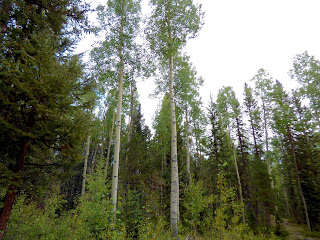5 mile hike (103 runtotal) near and in the North Slope Recreation Area. We hiked out on the Elder-Fehn trail in the Catamount Ranch Open Space and turned down Vayhinger trail to the Catamount-RTP trail down to the western end of the North Catamount Reservoir, then onto the Limber Pine trail back to the parking lot. Well-maintained trails and not difficult. Aspen already turning. I went and looked at old pictures to try to decide if this is earlier fall color - it does seem to be earlier than last year when we hiked the Macneil Trail, but on some hikes on Labor Day weekend in earlier years if we were high enough there was similar color. This is one we'd like to do again.
 |
| These three are Mississippi Kites in "my" trees this morning - juvenile and adult. |
 |
| The area above timberline on Pikes Peak had a lot of color to it today - goes to show it isn't all bare rock. |
 |
| Strawberry-colored Strawberry leaves. |
 |
| These are sapsucker wells probably made by a Yellow-bellied Sapsucker (a woodpecker) getting sap from the tree. |
 |
| Fount another bearing tree - that's at least 3 for us - we found one up near the Horns of Cheyenne Mountain, and one just off the Ice Cave Creek trail up by the Palmer Lake reservoirs. |
 |
| The beginnings of autumn color. |
 |
| I like the way this moon shot came out the moon looks pretty crisp to me and I like the really light clouds in the sky. |
 |
| These are the Crags from our viewpoint. |
 |
| A different angle of the Crags. |
 |
| These Blue Spruce standing alone in the Catamount Creek meadow we thought were pretty. |
 |
| Big variety of dandelion - seed head of one in an earlier picture. |
 |
| Hugging a BIG tree. |
 |
| Western end of the North Catamount Reservoir - no fee when you hike in from this side! |
 |
| Bottoms-up ducks in the reservoir. |
 |
| This was a pretty neat thing to come across. These are Aerial Yellowjackets. |
 |
| I thought these looked like tow eyes and a fossilized flying insect.... |
 |
| Check out these old ski slopes on the north side of Pikes Peak near the reservoirs. (1939 - 1984 (Did not operate 66/67, 80/81)) |
 |
| 120x zoom of the summit area from where we stood |
 |
| High zoom of the switchbacks of the Pikes Peak highway. |
 |
| There are several little patches of snow like this left - good chance they can last until winter. |
 |
| Yay, we were excited to run into some Gray Jays aka Camp Robbers or Whiskey Jacks back near the trail head. |
We encountered 3 Gray Jays, a family group - and I found this interesting explanation on Wikipedia about why three:
Gray jays typically breed at two years of age. Pairs are
monogamous and remain together for their lifetime, but a male or female will find another mate following the disappearance or death of their partner.
[4] Gray jay pairs breed during March and April, depending on latitude,
[4][5][6] in permanent, all-purpose territories.
[4][5][6][7] Second broods are not attempted, perhaps allowing greater time for food storage.
[4][5]
Gray jays
cooperatively breed.
[6][8][9] Strickland
[6] studied cooperative breeding of gray jays in
Algonquin Provincial Park, Ontario, and
La Verendrye Provincial Park, Quebec. In early June, when broods were 55 to 65 days old, the young fought amongst themselves until
dominant juveniles forced their siblings to leave the natal area. Dominant juveniles, known as "stayers", remained with their parents, and "leavers" left the natal territory to join an unrelated pair who failed to breed. Two-thirds of "stayers" were male.
[6]
During the
nest-building phase of the subsequent breeding season, approximately 65% of gray jay trios included "stayers" from the previous spring and their parents, and approximately 30% of trios included an unrelated "leaver". Occasionally, two nonbreeders accompany a pair of adults. "Stayers" may eventually inherit the natal territory and breed, and "leavers" may eventually fill a vacancy nearby or form a new breeding pair on previously unoccupied ground.
[6] The role of "stayers" is to retrieve caches and bring food to younger siblings;
[8][9]however, this is only allowed by the parents during the post
fledgling period.
[6][8][9] Until then, parents are hostile toward the "stayer". This may reduce the frequency of predator-attracting visits to the nest when young are most vulnerable. The benefits of allofeeding may include "lightening the load" for the breeding pair, which may possibly increase longevity, reducing the probability of starvation of nestlings, and detecting and mobbing predators near the nest.
[8]






































































No comments:
Post a Comment